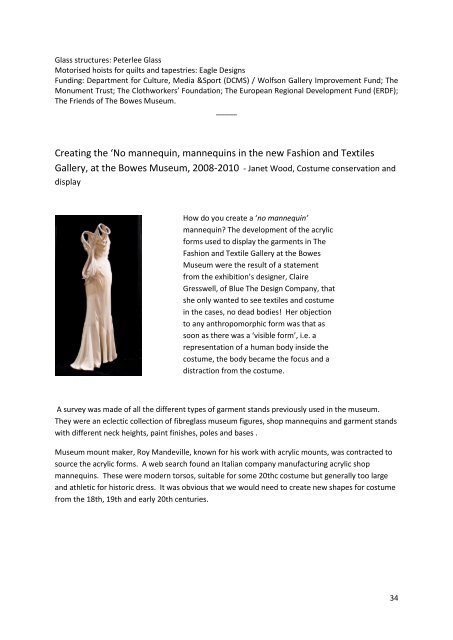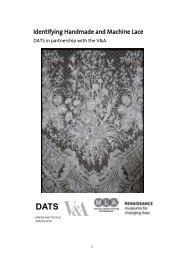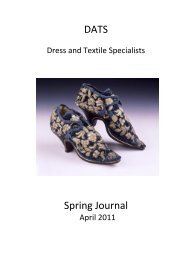Spring 2012 - Dress and Textile Specialists
Spring 2012 - Dress and Textile Specialists
Spring 2012 - Dress and Textile Specialists
You also want an ePaper? Increase the reach of your titles
YUMPU automatically turns print PDFs into web optimized ePapers that Google loves.
Glass structures: Peterlee Glass<br />
Motorised hoists for quilts <strong>and</strong> tapestries: Eagle Designs<br />
Funding: Department for Culture, Media &Sport (DCMS) / Wolfson Gallery Improvement Fund; The<br />
Monument Trust; The Clothworkers’ Foundation; The European Regional Development Fund (ERDF);<br />
The Friends of The Bowes Museum.<br />
_____<br />
Creating the ‘No mannequin, mannequins in the new Fashion <strong>and</strong> <strong>Textile</strong>s<br />
Gallery, at the Bowes Museum, 2008-2010 - Janet Wood, Costume conservation <strong>and</strong><br />
display<br />
How do you create a ‘no mannequin’<br />
mannequin? The development of the acrylic<br />
forms used to display the garments in The<br />
Fashion <strong>and</strong> <strong>Textile</strong> Gallery at the Bowes<br />
Museum were the result of a statement<br />
from the exhibition’s designer, Claire<br />
Gresswell, of Blue The Design Company, that<br />
she only wanted to see textiles <strong>and</strong> costume<br />
in the cases, no dead bodies! Her objection<br />
to any anthropomorphic form was that as<br />
soon as there was a ‘visible form’, i.e. a<br />
representation of a human body inside the<br />
costume, the body became the focus <strong>and</strong> a<br />
distraction from the costume.<br />
A survey was made of all the different types of garment st<strong>and</strong>s previously used in the museum.<br />
They were an eclectic collection of fibreglass museum figures, shop mannequins <strong>and</strong> garment st<strong>and</strong>s<br />
with different neck heights, paint finishes, poles <strong>and</strong> bases .<br />
Museum mount maker, Roy M<strong>and</strong>eville, known for his work with acrylic mounts, was contracted to<br />
source the acrylic forms. A web search found an Italian company manufacturing acrylic shop<br />
mannequins. These were modern torsos, suitable for some 20thc costume but generally too large<br />
<strong>and</strong> athletic for historic dress. It was obvious that we would need to create new shapes for costume<br />
from the 18th, 19th <strong>and</strong> early 20th centuries.<br />
34





